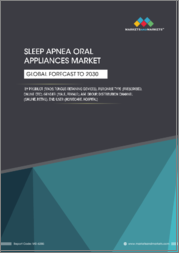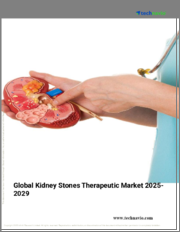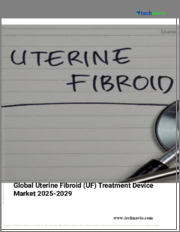
|
시장보고서
상품코드
1374818
세계의 비강 측정 시스템 시장(2023-2030년)Global Rhinometry Systems Market -2023-2030 |
||||||
개요
비강내압 측정은 호흡 시 코의 압력과 기류를 측정하는 것으로, 코의 기도 저항을 측정하고 코의 개방성을 평가하는 표준 기술로 인정받고 있습니다. 음향식 비강 측정은 반사된 소리 신호를 이용하여 비강의 단면적과 부피를 측정합니다.
비강 측정은 수술을 위한 환자 선택을 개선하고, 비폐색의 구조적 원인과 기능적 원인을 구별하고, 비밸브 폐쇄 장애를 진단하고, 모순된 증상과 검사 결과를 명확히 하고, 의료 법의학 도구로 편리하며, 비강 알레르겐의 치료 도구로 사용됩니다.
시장 역학: 성장 촉진요인 및 억제요인
알레르기성 비염의 유병률 증가
알레르기성 비염의 유병률 증가는 예측 기간 동안 비강 측정 시스템 시장을 주도하는 중요한 주요 요인 중 하나입니다. 예를 들어, National Library of Medicine 2023에 게재된 논문에 따르면 알레르기성 비염의 유병률은 2017년에서 2022년 사이에 1.83%에서 9.23%로 증가했으며, 코로나19 팬데믹 전후에는 21.38에서 70.22%로 크게 감소했습니다. 6세에서 18세 사이에서는 여성보다 남성의 유병률이 더 높았으며, 6세에서 18세 사이에서는 여성보다 남성의 유병률이 더 높았습니다. 이러한 요인은 예측 기간 동안 시장 성장을 가속하는 데 도움이 될 것입니다.
또한, 세계 비강 측정 시스템 시장은 라이노메트리 기술 발전, 비강 질환의 유병률 증가, 비침습적 진단 기술의 보급 등 다양한 요인에 의해 주도되고 있으며, 이는 예측 기간 동안 시장 성장을 가속할 것으로 예상됩니다.
시장 역학: 억제요인
비강 측정 시스템의 높은 비용과 비강 측정 시스템의 초기 투자 및 유지보수 비용은 상당한 금액이 될 수 있으며, 특히 개발도상국의 의료 시설에 큰 부담이 될 수 있습니다. 이러한 높은 시스템 관련 비용으로 인해 채택이 제한되어 시장 성장을 저해할 수 있습니다.
또한, 숙련된 전문가가 부족하기 때문에 비강 측정 시스템을 효과적으로 사용하려면 이러한 장비에서 얻은 데이터를 정확하게 해석할 수 있는 숙련된 의료 전문가가 필요합니다. 일부 지역에서는 숙련된 인력이 부족하여 시장 성장에 걸림돌이 될 수 있습니다. 의료 전문가들에게 비강 측정 시스템의 사용법과 해석에 대해 교육하고 훈련시키는 노력이 필요합니다.
목차
제1장 조사 방법과 조사 범위
제2장 정의와 개요
제3장 주요 요약
제4장 시장 역학
- 영향요인
- 성장 촉진요인
- 성장 억제요인
- 기회
- 영향 분석
제5장 산업 분석
- Porter의 Five Forces 분석
- 공급망 분석
- 가격 분석
- 규제 분석
- 러시아·우크라이나 전쟁의 영향 분석
- DMI의 견해
제6장 COVID-19 분석
제7장 제품 유형별
- 음향비강통기도검사(Acoustic Rhinometry)
- Optical Rhinometry
- Impedance Rhinometry
제8장 용도별
- 알레르기 진단
- 코 수술
- 호흡기질환 진단
- 기타
제9장 최종사용자별
- 병원
- 이비인후과 클리닉
- 외래수술센터(ASC)
- 기타
제10장 지역별
- 북미
- 미국
- 캐나다
- 멕시코
- 유럽
- 독일
- 영국
- 프랑스
- 이탈리아
- 스페인
- 기타 유럽
- 남미
- 브라질
- 아르헨티나
- 기타 남미
- 아시아태평양
- 중국
- 인도
- 일본
- 호주
- 기타 아시아태평양
- 중동 및 아프리카
제11장 경쟁 구도
- 경쟁 시나리오
- 시장 현황/점유율 분석
- 인수합병(M&A)분석
제12장 기업 개요
- Happersberger otopront GmbH
- 기업 개요
- 제품 포트폴리오와 설명
- 재무 개요
- 주요 동향
- ECLERIS
- GM Instruments
- Homoth Medizinelektronik GmbH & Co
- Recorders and Medicare
- ATMOS MedizinTechnik GmbH
- Sensonics International
- Piston Medical
- BioRESEARCH Associates, Inc
- HealthManagement
제13장 부록
LSH 23.11.14Overview
Rhinomanometry, which measures nasal pressure and airflow during breathing, is accepted as the standard technique for measuring nasal airway resistance and assessing the patency of the nose. Acoustic rhinometry uses a reflected sound signal to measure the cross-sectional area and volume of the nasal passage.
Rhinomanometry is useful to improve patient selection for surgery, distinguish between structural and functional causes of nasal obstruction, diagnose nasal valve collapse, clarify conflicting symptoms and exam findings, use as a medicolegal tool and in nasal allergen challenges.
Market Dynamics: Drivers and Restraints
Rise in the prevalence of allergic rhinitis
The rise in the prevalence of allergic rhinitis is one of the significant key factors that drive the rhinometry systems market during the forecast period. For instance, according to the article published in the National Library of Medicine 2023, the prevalence of allergic rhinitis cases ranged from 1.83 to 9.23% between 2017 and 2022. There was a significant drop of 21.38 to 70.22% between the pre- and post-COVID-19 pandemic. Males were more prevalent in the 6 to 18-year-olds than females. Thus, the above factors help to drive market growth during the forecast period.
Furthermore, the global rhinometry systems market is also driven by various factors like technological advancements in rhinometry, a rise in the prevalence of nasal disorders, a rise in non-invasive diagnostic techniques and others that will drive the market growth during the forecast period.
Market Dynamics: Restraint
High costs associated with rhinometry systems, the initial investment and maintenance costs of rhinometry systems can be substantial, posing a challenge for healthcare facilities, particularly in developing regions. The high costs associated with these systems may limit their adoption, hindering market growth.
Also, lack of skilled professionals the effective use of rhinometry systems requires trained healthcare professionals who can accurately interpret the data obtained from these devices. The shortage of skilled personnel in certain regions may pose a restraint to market growth. Efforts should be made to train and educate healthcare professionals on the usage and interpretation of rhinometry systems.
Segment Analysis
The global rhinometry systems is segmented based on product type, application, end-user and region.
The acoustic rhinometry from the product type segment accounted for approximately 41.2% of the market share
The acoustic rhinometry from the product type segment accounted for 41.2% and it is expected to be dominated during the forecast period. Acoustic rhinometry is a new technique which evaluates nasal obstruction by analysing reflections of a sound pulse introduced via the nostrils. The technique is rapid, reproducible, non-invasive and requires minimal cooperation from the subject. Unlike rhinomanometry, it does not require airflow. A graph of the nasal cross-sectional area as a function of distance from the nostril is produced, from which several area and volume estimates of the nasal cavity can be derived.
The role of acoustic rhinometry in diagnosis is quantifying nasal obstruction. This procedure is particularly important with secondary rhinoplasty patients whose complaints include substantial functional problems in addition to aesthetic concerns.
Geographical Analysis
North America accounted for approximately 38.4% of the market share in 2022
North America is estimated to hold about 38.4% of the total market share throughout the forecast period, owing to be attributed to well-established healthcare infrastructure, rising prevalence of septal deviation, and technological advancements in rhinometry systems in the region. In terms of revenue.
For instance, in March 2020, GM Instruments stated that an exclusive distribution partnership with BioResearch Associates Inc. This partnership supports the North American market expansion into the dental/dental sleep market with a reputable partner experienced in innovative ENT products.
Alongside our distribution partner, we are implementing a collaborative, interdisciplinary approach to patient care and outcomes with a network of dentists and ENTs. There is a need for healthcare policy financial considerations and if 20% of the patients undergoing unnecessary septal surgical intervention were identified pre-operatively then potentially 12 million pounds could be saved with an additional significant reduction in the number of NHS hospital bed days wasted.
COVID-19 Impact Analysis
The COVID-19 pandemic has had a significant impact on the healthcare industry, including the rhinometry systems market. The pandemic has highlighted the importance of non-invasive diagnostic techniques, remote monitoring, and telemedicine. Rhinometry systems, with their non-invasive nature and potential for remote patient care, have gained prominence during the pandemic.
Competitive Landscape
The major global players in the rhinometry systems market include Happersberger otopront GmbH , ECLERIS, GM Instruments, Homoth Medizinelektronik GmbH & Co, Recorders and Medicare, ATMOS MedizinTechnik GmbH , Sensonics International , Piston Medical, BioRESEARCH Associates, Inc, HealthManagement and among others.
Key Developments
- In June 2022, Vivos Therapeutics signed an exclusive distribution agreement with GM Instruments for the NR6 Rhinomanometer, an FDA-approved device used to measure nasal airway resistance, for treating dentofacial abnormalities and OSA in adults.
Why Purchase the Report?
- To visualize the global rhinometry systems market segmentation-based product type, application, end-user and region as well as understand key commercial assets and players.
- Identify commercial opportunities by analyzing trends and co-development.
- Excel data sheet with numerous data points of rhinometry systems market-level with all segments.
- PDF report consists of a comprehensive analysis after exhaustive qualitative interviews and an in-depth study.
- Product mapping available as excel consisting of key products of all the major players.
The global rhinometry systems market report would provide approximately 69 tables, 70 figures, and 185 Pages.
Target Audience 2023
- Manufacturers/ Buyers
- Industry Investors/Investment Bankers
- Research Professionals
- Emerging Companies
Table of Contents
1. Methodology and Scope
- 1.1. Research Methodology
- 1.2. Research Objective and Scope of the Report
2. Definition and Overview
3. Executive Summary
- 3.1. Snippet by Product Type
- 3.2. Snippet by Application
- 3.3. Snippet by End User
- 3.4. Snippet by Region
4. Dynamics
- 4.1. Impacting Factors
- 4.1.1. Driver
- 4.1.1.1. Rise in the prevalence of allergic rhinitis
- 4.1.1.2. Rise in the technology advancements
- 4.1.2. Restraints
- 4.1.2.1. High cost associated with the equipment
- 4.1.3. Opportunity
- 4.1.4. Impact Analysis
- 4.1.1. Driver
5. Industry Analysis
- 5.1. Porter's Five Force Analysis
- 5.2. Supply Chain Analysis
- 5.3. Pricing Analysis
- 5.4. Regulatory Analysis
- 5.5. Russia-Ukraine War Impact Analysis
- 5.6. DMI Opinion
6. COVID-19 Analysis
- 6.1. Analysis of COVID-19
- 6.1.1. Scenario Before COVID
- 6.1.2. Scenario During COVID
- 6.1.3. Scenario Post COVID
- 6.2. Pricing Dynamics Amid COVID-19
- 6.3. Demand-Supply Spectrum
- 6.4. Government Initiatives Related to the Market During Pandemic
- 6.5. Manufacturers Strategic Initiatives
- 6.6. Conclusion
7. By Product Type
- 7.1. Introduction
- 7.1.1. Market Size Analysis and Y-o-Y Growth Analysis (%), By Product Type
- 7.1.2. Market Attractiveness Index, By Product Type
- 7.2. Acoustic Rhinometry *
- 7.2.1. Introduction
- 7.2.2. Market Size Analysis and Y-o-Y Growth Analysis (%)
- 7.3. Optical Rhinometry
- 7.4. Impedance Rhinometry
8. By Application
- 8.1. Introduction
- 8.1.1. Market Size Analysis and Y-o-Y Growth Analysis (%), By Application
- 8.1.2. Market Attractiveness Index, By Application
- 8.2. Allergy Diagnosis*
- 8.2.1. Introduction
- 8.2.2. Market Size Analysis and Y-o-Y Growth Analysis (%)
- 8.3. Nasal Surgery
- 8.4. Respiratory Disease Diagnosis
- 8.5. Others
9. By End User
- 9.1. Introduction
- 9.1.1. Market Size Analysis and Y-o-Y Growth Analysis (%), By End User
- 9.1.2. Market Attractiveness Index, By End User
- 9.2. Hospitals *
- 9.2.1. Introduction
- 9.2.2. Market Size Analysis and Y-o-Y Growth Analysis (%)
- 9.3. ENT Clinics
- 9.4. Ambulatory Surgical Centers
- 9.5. Others
10. By Region
- 10.1. Introduction
- 10.1.1. Market Size Analysis and Y-o-Y Growth Analysis (%), By Region
- 10.1.2. Market Attractiveness Index, By Region
- 10.2. North America
- 10.2.1. Introduction
- 10.2.2. Key Region-Specific Dynamics
- 10.2.3. Market Size Analysis and Y-o-Y Growth Analysis (%), By Product Type
- 10.2.4. Market Size Analysis and Y-o-Y Growth Analysis (%), By Application
- 10.2.5. Market Size Analysis and Y-o-Y Growth Analysis (%), By End User
- 10.2.6. Market Size Analysis and Y-o-Y Growth Analysis (%), By Country
- 10.2.6.1. U.S.
- 10.2.6.2. Canada
- 10.2.6.3. Mexico
- 10.3. Europe
- 10.3.1. Introduction
- 10.3.2. Key Region-Specific Dynamics
- 10.3.3. Market Size Analysis and Y-o-Y Growth Analysis (%), By Product Type
- 10.3.4. Market Size Analysis and Y-o-Y Growth Analysis (%), By Application
- 10.3.5. Market Size Analysis and Y-o-Y Growth Analysis (%), By End User
- 10.3.6. Market Size Analysis and Y-o-Y Growth Analysis (%), By Country
- 10.3.6.1. Germany
- 10.3.6.2. UK
- 10.3.6.3. France
- 10.3.6.4. Italy
- 10.3.6.5. Spain
- 10.3.6.6. Rest of Europe
- 10.4. South America
- 10.4.1. Introduction
- 10.4.2. Key Region-Specific Dynamics
- 10.4.3. Market Size Analysis and Y-o-Y Growth Analysis (%), By Product Type
- 10.4.4. Market Size Analysis and Y-o-Y Growth Analysis (%), By Application
- 10.4.5. Market Size Analysis and Y-o-Y Growth Analysis (%), By Country
- 10.4.5.1. Brazil
- 10.4.5.2. Argentina
- 10.4.5.3. Rest of South America
- 10.5. Asia-Pacific
- 10.5.1. Introduction
- 10.5.2. Key Region-Specific Dynamics
- 10.5.3. Market Size Analysis and Y-o-Y Growth Analysis (%), By Product Type
- 10.5.4. Market Size Analysis and Y-o-Y Growth Analysis (%), By Application
- 10.5.5. Market Size Analysis and Y-o-Y Growth Analysis (%), By Country
- 10.5.5.1. China
- 10.5.5.2. India
- 10.5.5.3. Japan
- 10.5.5.4. Australia
- 10.5.5.5. Rest of Asia-Pacific
- 10.6. Middle East and Africa
- 10.6.1. Introduction
- 10.6.2. Key Region-Specific Dynamics
- 10.6.3. Market Size Analysis and Y-o-Y Growth Analysis (%), By Product Type
- 10.6.4. Market Size Analysis and Y-o-Y Growth Analysis (%), By Application
- 10.6.5. Market Size Analysis and Y-o-Y Growth Analysis (%), By End User
11. Competitive Landscape
- 11.1. Competitive Scenario
- 11.2. Market Positioning/Share Analysis
- 11.3. Mergers and Acquisitions Analysis
12. Company Profiles
- 12.1. Happersberger otopront GmbH
- 12.1.1. Company Overview
- 12.1.2. Product Portfolio and Description
- 12.1.3. Financial Overview
- 12.1.4. Key Developments
- 12.2. ECLERIS
- 12.3. GM Instruments
- 12.4. Homoth Medizinelektronik GmbH & Co
- 12.5. Recorders and Medicare
- 12.6. ATMOS MedizinTechnik GmbH
- 12.7. Sensonics International
- 12.8. Piston Medical
- 12.9. BioRESEARCH Associates, Inc
- 12.10. HealthManagement
LIST NOT EXHAUSTIVE
13. Appendix
- 13.1. About Us and Services
- 13.2. Contact Us



















